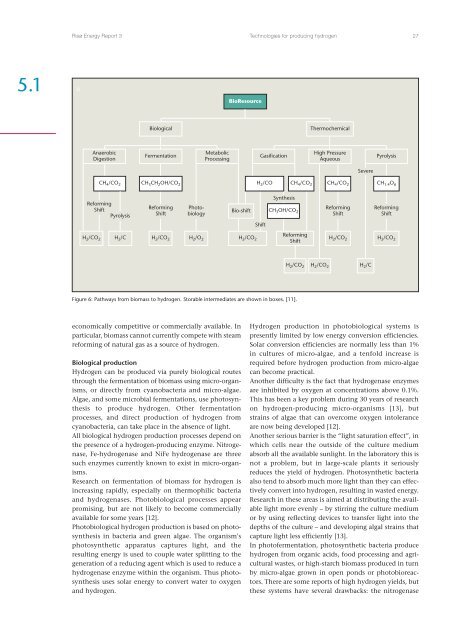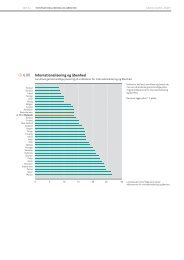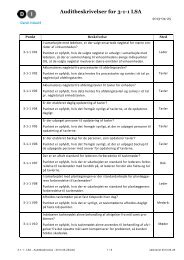Hydrogen and its competitors, 2004
Hydrogen and its competitors, 2004
Hydrogen and its competitors, 2004
You also want an ePaper? Increase the reach of your titles
YUMPU automatically turns print PDFs into web optimized ePapers that Google loves.
Risø Energy Report 3Technologies for producing hydrogen 275.10BioResourceBiologicalThermochemicalAnaerobicDigestionFermentationMetabolicProcessingGasificationHigh PressureAqueousPyrolysisSevereCH 4 /CO 2CH 3 CH 2 OH/CO 2H 2 /CO CH 4 /CO 2CH 4 /CO 2CH 1.4 O 6ReformingShiftPyrolysisReformingShiftPhotobiologyBio-shiftSynthesisCH 3 OH/CO 2ReformingShiftReformingShiftShiftReformingShiftH 2 /CO 2 H 2 /C H 2 /CO 2 H 2 /O 2 H 2 /CO 2H 2 /CO 2 H 2 /CO 2H 2 /CO 2H 2 /CH 2 /CO 2Figure 6: Pathways from biomass to hydrogen. Storable intermediates are shown in boxes. [11].economically competitive or commercially available. Inparticular, biomass cannot currently compete with steamreforming of natural gas as a source of hydrogen.Biological production<strong>Hydrogen</strong> can be produced via purely biological routesthrough the fermentation of biomass using micro-organisms,or directly from cyanobacteria <strong>and</strong> micro-algae.Algae, <strong>and</strong> some microbial fermentations, use photosynthesisto produce hydrogen. Other fermentationprocesses, <strong>and</strong> direct production of hydrogen fromcyanobacteria, can take place in the absence of light.All biological hydrogen production processes depend onthe presence of a hydrogen-producing enzyme. Nitrogenase,Fe-hydrogenase <strong>and</strong> NiFe hydrogenase are threesuch enzymes currently known to exist in micro-organisms.Research on fermentation of biomass for hydrogen isincreasing rapidly, especially on thermophilic bacteria<strong>and</strong> hydrogenases. Photobiological processes appearpromising, but are not likely to become commerciallyavailable for some years [12].Photobiological hydrogen production is based on photosynthesisin bacteria <strong>and</strong> green algae. The organism'sphotosynthetic apparatus captures light, <strong>and</strong> theresulting energy is used to couple water splitting to thegeneration of a reducing agent which is used to reduce ahydrogenase enzyme within the organism. Thus photosynthesisuses solar energy to convert water to oxygen<strong>and</strong> hydrogen.<strong>Hydrogen</strong> production in photobiological systems ispresently limited by low energy conversion efficiencies.Solar conversion efficiencies are normally less than 1%in cultures of micro-algae, <strong>and</strong> a tenfold increase isrequired before hydrogen production from micro-algaecan become practical.Another difficulty is the fact that hydrogenase enzymesare inhibited by oxygen at concentrations above 0.1%.This has been a key problem during 30 years of researchon hydrogen-producing micro-organisms [13], butstrains of algae that can overcome oxygen intoleranceare now being developed [12].Another serious barrier is the “light saturation effect”, inwhich cells near the outside of the culture mediumabsorb all the available sunlight. In the laboratory this isnot a problem, but in large-scale plants it seriouslyreduces the yield of hydrogen. Photosynthetic bacteriaalso tend to absorb much more light than they can effectivelyconvert into hydrogen, resulting in wasted energy.Research in these areas is aimed at distributing the availablelight more evenly – by stirring the culture mediumor by using reflecting devices to transfer light into thedepths of the culture – <strong>and</strong> developing algal strains thatcapture light less efficiently [13].In photofermentation, photosynthetic bacteria producehydrogen from organic acids, food processing <strong>and</strong> agriculturalwastes, or high-starch biomass produced in turnby micro-algae grown in open ponds or photobioreactors.There are some reports of high hydrogen yields, butthese systems have several drawbacks: the nitrogenase
















